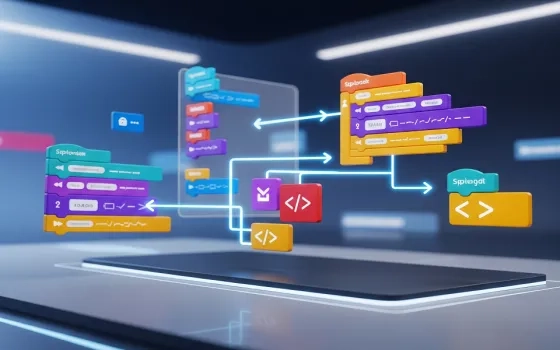There’s mounting pressure on modern enterprises to deliver within tight timelines while also catering to product customization and other special requirements. Due to this, enterprises are compelled to empower both technical and non-technical resources to keep up with the demands of the ever-evolving technology ecosystem. In addition, companies seek highly agile technologies that are responsive to changing customers’ needs. Low-code/no-code technology platforms have emerged in response to these challenges, enabling individuals with minimal or no programming expertise to build products and offer services without having to depend on programmers.
Simply put, low-code/no-code platforms help in simplifying and expediting the development process while also reducing ‘barriers to entry’ for budding enterprises. It has emerged as a boon in disguise for businesses seeking a competitive edge in today’s marketing landscape. According to Gartner’s forecast, in 2023, the global low-code/no-code market is expected to reach a total of $26.9 billion - that’s a 19.6% growth compared to 2022. Furthermore, the adoption of LCNC tools and platforms is expected to accelerate through 2026.
This blog post explores how low-code/no-code development is poised to be the next big thing in enterprise technology.
What is low-code/no-code (LCNC)?
Low-code/no-code is the latest software development methodology that enables users to build applications without writing code. These platforms are the perfect solution for organizations that do not want to invest extensive time or effort into development.
In low-code, users build the application by assembling code snippets and may use minimal custom code to meet the application’s specific needs. No-code completely eliminates the need for users to write code - Users utilize visual tools, mostly drag-and-drop interfaces, to design and configure simple apps.
Evolution of low-code/no-code tools
Low-code/no-code platforms began evolving from rapid application development (RAD) tools such as Excel and Microsoft Access that allow for some development-like capabilities to empower business users i.e., non-IT professionals.
However, those tools required users to thoroughly understand the business apps in order to build capabilities. In contrast, with low-code and no-code options' drag-and-drop features, users need either minimal or no knowledge of the tools or development in general. WordPress is a good example of a low-code platform that provides easy drag-and-drop capabilities as well as an extensive library of widgets and plugins for every functionality.
Advantages of adopting low-code/no-code
Meet Growing Demands of Enterprises
According to Gartner, there will be a 5-fold surge in demand for mobile app development in the coming years, surpassing the current IT capacity to deliver them. With low-code/no-code citizen development, meeting and satisfying these growing needs is easier; developers can focus on the intricate technical aspects of the application development and assign straightforward tasks to non-technical stakeholders, thus seamlessly catering to users’ needs.
Improved Agility
As consumer needs are changing at an unprecedented rate, there’s a dire need for enterprises to possess a high degree of agility to stay competitive in the market. Many enterprises have begun turning away from rigid, hard-to-customize IT systems and exploring the potential benefits of low-code/no-code development. Gartner estimates that by 2025, 70% of enterprise applications will utilize low-code/no-code platforms and tools for their system development.
Low-code/no-code platforms offer simple and user-friendly drag-and-drop interfaces that make it convenient for businesses to build new applications as well as revamp existing ones. Organizations can swiftly develop and deploy new features and reach the market earlier than their competitors, who rely on traditional application development methods. This results in accelerated delivery and lucrative marketing prospects.
Accessibility for All
A few years ago, small enterprises were at the receiving end of various technology challenges - they lacked the resources and funding to build and sustain applications. Nonetheless, the advent of cloud technology has turned the tables. Today, enterprises of varying sizes have the favorable opportunity to build applications using low-code/no-code methodologies and efficiently navigate the modern business landscape.
Reduced IT Dependency
Traditional work models had a high degree of developers’ involvement and limited participation of non-technical personnel. Now, individuals outside IT departments, such as marketers and business analysts, can address basic software development requirements, allowing developers to focus on areas that actually require their coding acumen.
Best Utilization of Internal Resources
No-code/low-code platforms usually offer an intuitive and easy-to-design interface, enabling staff with no programming knowledge to independently design applications with minimal or no assistance. The reduced reliance on developers’ expertise allows the business to leverage current resources who have a comprehensive understanding of the issue rather than hiring someone from outside. This technique ensures optimum utilization of internal resources and boosts the team’s problem-solving ability and creativity.
Lower Expenditure
As explained earlier, the ease of use offered by low-code/no-code technology results in faster delivery, increased efficiency, and reduced costs. These benefits encompass:
- Eliminating the requirement for expensive software engineers
- Low maintenance as there is no need for costly software and hardware requisites
- Shorter duration of the software development life cycle
Increased Collaboration
In an effort to deliver fast, businesses often resort to external software solutions without consulting their in-house personnel. But the no-code citizen app negates this need. The app allows individuals to work independently while having the option to collaborate with other teams. This process promotes greater collaboration and mitigates potential risks associated with external resources.
How to identify projects suitable for low-code and no-code approaches?
Before plunging into a low-code or no-code approach, enterprises must assess the project’s requirements, complexity, and customization needs. Here are some strategies to evaluate these factors.
1. Analyze key requirements
Conduct a detailed analysis of the project and its requirements. Low-code/no-code platforms can seamlessly implement projects that already have a standardized process, defined scope, and workflows.
2. Evaluate project complexity
Assess the project’s complexity based on business logic, programming skills, and development steps. For large projects requiring critical stages such as requirement gathering, design, development, testing, and deployment, a low-code/no-code may not be a feasible option.
3. Comprehend stakeholders’ technical expertise
Gauge the technical proficiency of stakeholders - if they have limited programming knowledge, low-code/no-code is likely the best option to develop applications.
4. Look for repetitive tasks
If the project has repetitive tasks that can be automated to reduce the time and effort required for implementation and delivery, then the project can be efficiently implemented using low-code or no-code platforms.
Applications that can be built using low-code/no-code platforms
There is no universal approach when it comes to technology adoption in enterprises. Some can benefit extensively from implementing low-code and no-code development. Here are a few examples:
- New web-based, mobile-based business applications
- Simple reporting applications that involve basic CRUD (Create, Read, Update, and Delete) functions and integration workflows
- Multi-channel applications
- Legacy applications with simplified and standardized features
Conclusion
Low-code and no-code platforms have far-reaching implications in the software development process - they extend beyond their capacity to foster team collaboration and accelerate product and service delivery. The technology is highly flexible as well as scalable, helping businesses adapt swiftly to changing trends and stay ahead of the learning curve.




















